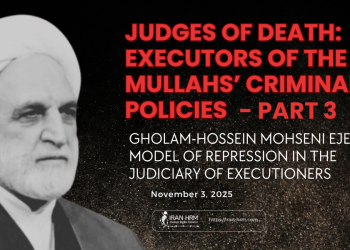Introduction
September 10, World Suicide Prevention Day, is an opportunity for global attention to one of the most pressing social and human rights challenges. In Iran, under the rule of the mullahs’ regime, this day carries a more painful meaning than ever. Suicide is no longer merely an individual or psychological phenomenon; it has become a national crisis rooted in poverty, unemployment, discrimination, political repression, and the loss of social hope.
With thousands ending their lives every year in Iran and hundreds of thousands of failed attempts recorded, suicide has become the emblem of a life trapped in unbearable deadlock.
Overview of the Crisis
Suicide in Iran has become one of the leading causes of death and is on a sharp upward trend. Even regime officials have been forced to admit this reality.
Hamid Ya’qubi, head of Iran’s Suicide Prevention Association, has stated that in the past four years, suicide-related deaths have increased by 10 percent annually. He emphasized that in 2022 (Solar Hijri year 1401), more than 6,900 people lost their lives. According to the latest figures, this number has now reached around 7,000 deaths per year.
This corresponds to about 150,000 suicide attempts and more than three million cases of suicidal ideation. The highest number of deaths belong to workers (32%), while among those attempting suicide, housewives rank first with 32.8%.
Complementary reports indicate:
- Between 2016 and 2022, Iran’s suicide rate increased by more than 51 percent.
- The annual number of cases has risen from about 3,500 to over 5,000, reflecting a growing humanitarian crisis over the past decade.
- The suicide rate has climbed from 4.7 per 100,000 people in 2011 to 8.9 in 2023, and it is projected to reach 9.7 in 2024. The province of Ilam, with 18.7 per 100,000 people, holds the national record.
These figures show that the suicide crisis is not only expanding but that the regime, through its policy of concealment, is deliberately attempting to hide its real dimensions.
Root Causes of Suicide in Iran
1. Unemployment and the Lost Future of the Young Generation
Millions of educated young people remain without jobs and prospects. The mass emigration of skilled youth and the accumulation of social despair have pushed many to the brink of psychological collapse.
2. Life Below the Poverty Line
Runaway inflation and the collapse of the national currency have made even basic needs unattainable. In July 2022, a five-member family in Najafabad committed collective suicide. In just the past few months, at least 10 workers have ended their lives due to economic pressure. Even regime media have admitted that 7 million employees in Iran lack job security.
According to various reports:
- In 2022, it was reported that about 60 million people (75% of the population) were living below the poverty line.
- In the current crisis outlook – August 2025, a regime-affiliated economist admitted that 80% of Iran’s population is at risk of poverty, the direct result of the regime’s financial and monetary policies.
3. Political and Social Pressures
The suppression of protests, lack of social freedoms, and systemic discrimination have pushed society into a “psychological dead end.”
4. Tragedy Among Physicians and Medical Residents
Reports indicate a shocking rise in suicides among doctors and medical residents:
- According to official statistics, in the past year 16 residents committed suicide—a rate of about 100 per 100,000, nearly ten times higher than the general population average.
- In the first 47 days of last year alone, 5 doctors ended their lives.
Job-related stress, meager wages, exhausting working hours, and the lack of psychological support have been cited as the main drivers of this crisis. Even regime-linked sources have warned that the interval between physician suicides has “shrunk to just 10 days.”
This reality shows that the crisis has engulfed not only the most deprived classes but also the country’s professionals and elites.
The Growing Surge of Suicides Among Women
Iranian women and girls are on the frontlines of this crisis. For many of them, suicide often becomes the final escape from the deadlock of an unbearable life.

- Forced marriages and child marriage: The regime’s misogynistic laws permit the marriage of girls at very young ages, leading repeatedly to the suicides of teenage girls.
- Domestic violence and discrimination: Women are denied any legal protection against violence.
- Forms of protest: Self-immolation has become one of the most common methods of suicide among women, widely recognized as a “silent protest.”
Documented cases include:
- Biri Mostafazadeh, a deaf Kurdish woman in Mahabad, who self-immolated after being dismissed from her job.
- Elena and Elisa, two sisters aged 13 and 14, who threw themselves from a high-rise in Hakimiyeh, Tehran.
- Shima Rameshk, a 14-year-old girl and victim of child marriage, who ended her life in September 2024.
- Sayan Tavangari, an 18-year-old girl, who committed suicide due to her inability to afford university tuition.
- Diana Rahmani in Salas Babajani, who was forced into marriage with an older man and took her own life.
According to regime reports, 52% of suicide victims among adolescents are girls.
Ethnic Minorities and Marginalized Regions
In Iran’s Kurdish provinces and border regions, suicide rates are significantly higher than the national average. Ilam province, with 18.7 suicides per 100,000 people, holds the highest rate in the country.
Kulbars (cross-border porters), driven by poverty and deprivation, have repeatedly committed suicide—including a 15-year-old teenage kulbar. Kurdish women, in many cases, end their lives through self-immolation.
Human rights reports emphasize that instead of addressing deprivation, the regime ruling Iran has intensified ethnic discrimination and repression.
Political Prisoners and Detainees: Suspicious Deaths Labeled as “Suicides”
Suspicious deaths of political prisoners and detainees, repeatedly described by officials as “suicides,” represent one of the most shocking aspects of the crisis. Evidence and testimonies show that these deaths are in fact the direct result of torture, sexual assault, psychological pressure, and the deliberate denial of medical care.
Documented cases:
- Sina Ghanbari (22 – Kahrizak, January 2018): His death was labeled “suicide,” yet signs of torture and beating were visible on his body.
- Vahid Heydari (Arak protester, 2018): Died in detention, officially declared “suicide,” while multiple signs of beating were evident.
- Arshia Emam-Qolizadeh (16): Only two days after release from short-term detention, he hanged himself. Activists say security pressure was the direct cause of his death.
- Yalda Aghafazli (19): After being arrested during protests and conditionally released, she died five days later under severe psychological pressure and security threats. The judiciary claimed “drug use,” but relatives testified she was driven to death by ongoing threats and harassment.
- Arian Yavari (17): After 70 days in detention and release on bail, he ended his life under constant security pressure.
- Shahin Golehdari (46): In Urmia Prison, he committed suicide under continuous harassment by the prison warden.
- Dr. Aida Rostami: A physician of the 2022 uprising who treated wounded protesters. In December 2022, she was abducted, and her body, bearing severe signs of torture, was returned. The regime declared her cause of death a “car accident.”
- Nika Shakarami (16): One of the most recognized victims of the 2022 uprising. After her arrest, she was brutally raped and then murdered. The regime claimed she “committed suicide,” while evidence revealed the direct involvement of IRGC agents in her detention and assault.
- Mousa Esmaeili and Peyman Galvani: Two Kurdish prisoners killed under torture in Ministry of Intelligence detention centers, but officially registered as “suicides.”
Broader evidence:
- Amnesty International documented at least 45 protesters of the 2022 uprising subjected to torture and sexual violence; among 26 shocking testimonies, 7 were children under 18. A mother testified that her high school son “attempted suicide twice” while in detention.
- Hamzeh Darvish, a Sunni prisoner in Lakan Prison, Rasht, wrote to the UN Special Rapporteur: “Prison officials told me there are easier ways to commit suicide.” He revealed that prison authorities drove inmates to death with drugs such as propranolol; in just one ward, more than 9 inmates died this way.
- In November 2023, reports stated that in Lakan Prison, Rasht, 20 inmates attempted suicide in a single month. One of them, Sohrab Azadbar, died after taking methadone.
- Other cases include: Payam Sattari (Kurdish political prisoner) who killed himself after continuous threats and pressure; Farhad and Fardin Aghazadeh, two imprisoned brothers in Urmia, who committed suicide after torture; and Masoumeh Sanoubari, a political prisoner in Fardis, who slit her veins in protest against torture.
These accounts make clear that the regime uses the label of “suicide” as a political tool to cover up state-sponsored killings.
Conclusion
World Suicide Prevention Day is a reminder of the responsibility of governments to reduce human suffering and protect the lives of their citizens. Yet in Iran, under the rule of the mullahs’ regime, not only has no preventive action been taken, but the regime itself—through destructive economic policies, political repression, gender and ethnic discrimination, and torture and killings in prisons—is the direct driver of this escalating crisis.
Suicide in Iran is no longer an individual choice born of personal hardship; it is the outcome of a repressive system that has pushed millions into a dead end. Under these conditions, World Suicide Prevention Day for the people of Iran carries above all the meaning of exposing the regime’s destructive role and demanding international accountability.
Call to Action
We call on the UN Human Rights Council, the UN Special Rapporteur, and international bodies to initiate an independent investigation into this crisis and to pressure the Iran regime to disclose accurate statistics and change its destructive policies.







